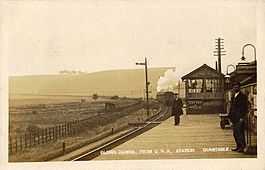Dunstable Town railway station
| Dunstable Town | |
|---|---|
 |
|
| Location | |
| Place | Dunstable |
| Area | Central Bedfordshire |
| Grid reference | TL026219 |
| Operations | |
| Original company | Luton, Dunstable and Welwyn Junction Railway |
| Pre-grouping | Hertford, Luton and Dunstable Railway Great Northern Railway |
| Post-grouping |
London, Midland and Scottish Railway London Midland Region of British Railways |
| Platforms | 1 |
| History | |
| 3 May 1858 | Opened as Dunstable Church Street |
| 1 January 1927 | Renamed Dunstable Town |
| 7 December 1964 | Goods facilities withdrawn |
| 26 April 1965 | Closed to passenger traffic |
| 17 January 1987 | Last train calls at station |
| Disused railway stations in the United Kingdom | |
| Closed railway stations in Britain A B C D–F G H–J K–L M–O P–R S T–V W–Z |
|
|
|
|
Dunstable Town, also known as Dunstable Church Street, was a railway station on the Great Northern Railway's branch line from Welwyn which served Dunstable in Bedfordshire from 1858 to 1965. Against a background of falling passenger numbers and declining freight returns, the station closed to passengers in 1965 and to goods in 1964, a casualty of the Beeching Axe. The station site is intended to be reused as part of the Luton Dunstable Busway.
The Luton, Dunstable and Welwyn Junction Railway (LD&WJR) was authorised on 16 July 1855 and empowered the construction of a 5 miles 45 chains (9.0 kilometres) line from Dunstable to join the Great Northern Railway's (GNR) main line at Digswell. The line would run from a junction near the London and North Western Railway's (LNWR) Dunstable station across the road now known as the A5 to a second station in Dunstable at Church Street. Finding itself in financial difficulties, the LD&WJR merged with the Hertford and Welwyn Junction Railway on 28 June 1858, thereby creating the Hertford, Luton and Dunstable Railway. The line opened between Dunstable and Luton to goods traffic on 5 April 1858, to passengers on 3 May and throughout to Welwyn on 1 September 1860. Trains were worked for two years by the LNWR after which the GNR took over, eventually acquiring the line on 12 June 1861.
The opening date of the station in Church Street, Dunstable, is disputed; sources differ between 1858 and 1860. In any event, it appears that the station may have opened as a consequence of the failure by the LNWR and GNR to agree terms for a joint station in Dunstable. The initial station was a simple timber-built structure with a single platform which proved unsuitable to handle the line's traffic and which soon generated numerous complaints from passengers. The GNR, whose Church Street station was more convenient for the town centre than the LNWR's Dunstable station, offered to rebuild the station so that it could also be used by the LNWR but the latter insisted on having equal rights of access which was unacceptable to the GNR. Following a fire in September 1871, a more permanent structure was provided at a cost of £1,500 (£NaN in 2017).
...
Wikipedia
